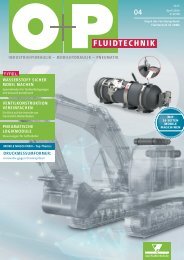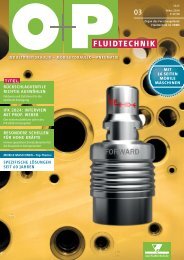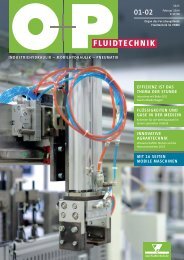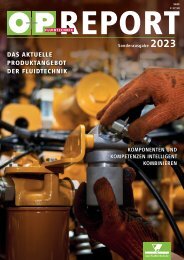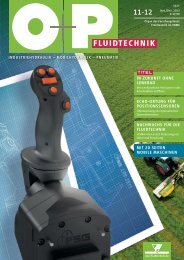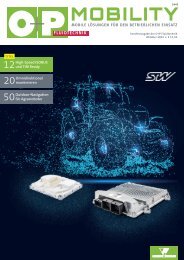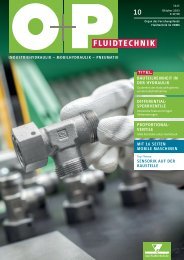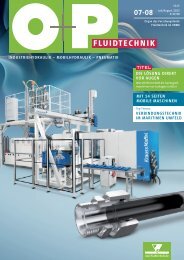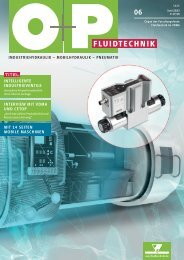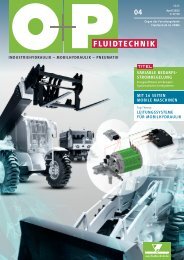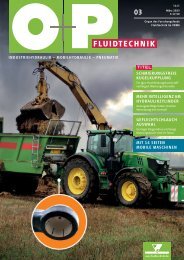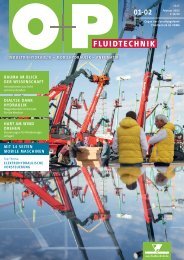O+P Fluidtechnik 10/2016
O+P Fluidtechnik 10/2016
O+P Fluidtechnik 10/2016
Sie wollen auch ein ePaper? Erhöhen Sie die Reichweite Ihrer Titel.
YUMPU macht aus Druck-PDFs automatisch weboptimierte ePaper, die Google liebt.
STEUERUNGEN UND REGELUNGEN<br />
1 INTRODUCTION<br />
As the demand for intelligent hydraulic systems increases, there is an<br />
increasing demand for hydraulic components with integrated sensing<br />
capability. The addition of sensors can enable improved performance<br />
and increased functionality, particularly when combined with<br />
intelligent controllers. However, the reputation of electronics and<br />
sensors as less reliable than purely mechanical devices can be a significant<br />
barrier to the adoption of intelligent machines. This can be particularly<br />
true if feedback from sensors is relied upon for baseline or<br />
safe operation, and a faulty sensor could render a machine inoperable.<br />
The development of fail-operational controllers, which offer<br />
some level of functionality in the presence of a sensor failure, can reduce<br />
the real and perceived risk of downtime due to a failed sensor.<br />
The Eaton CMA valve, is an example of an intelligent hydraulic<br />
valve that relies on sensor feedback for operation. It is a two-stage<br />
independent metering valve with a position sensor and a pressure<br />
sensor for each control spool. The closed-loop control of the<br />
spool position enables fast performance and zero hysteresis, but<br />
it also creates a reliance on the position sensor for operation.<br />
Pressure sensor feedback is used to enable features such as digital<br />
pressure compensation, load direction detection, back pressure<br />
control, and electronic load sense, among others. In typical operation,<br />
all four sensors are used to make the valve function. However,<br />
there is a redundancy that exists when the two spools are<br />
being used to control two sides of the same actuator. Since there<br />
is a relationship between valve position, pressure drop, and flow,<br />
and there is a known relationship between the flow in and the<br />
flow out of an actuator, only three of the four sensors are needed<br />
to have complete information about the state of the valve. Thus,<br />
while purely redundant sensors are often cost prohibitive, the redundancy<br />
provided by knowledge of an actuator area ratio can be<br />
utilized to develop fail operational controllers.<br />
Detecting and diagnosing a faulty sensor is a critical component<br />
of creating fault tolerant systems. There are many methods for detecting<br />
faults in a system, some of which, such as sensor out-ofrange<br />
detection, can immediately identify a faulty sensor. In other<br />
methods, such as poor demand tracking or a mismatch between<br />
the estimated flow in and out of an actuator, they can detect a fault<br />
somewhere in this system, but cannot determine the root cause<br />
without additional tests. For the purposes of this paper, it is assumed<br />
that a sensor fault has been detected and correctly identified.<br />
Once a fault has been identified, reconfigured control modes can<br />
allow the valve to operate with any one of the four sensors failed.<br />
In the next section, the structure and operation of the controller<br />
for a fault in any of the four sensors is described.<br />
2 FAIL OPERATIONAL MODES<br />
The basic principle of the fault tolerant control algorithms is described<br />
as cross-port pressure control, which essentially uses the faulty<br />
side of the valve to control the pressure on the non-faulty side of the<br />
valve. With a valve that has independent control of the meter-in and<br />
meter-out spools, there are numerous methods for controlling the<br />
two work ports. In most cases, an actuator is given a flow command,<br />
which is typically realized by controlling the flow across the spool<br />
that is holding the load.<br />
In a valve with digital pressure compensation, the measured<br />
pressure across the valve and the flow demand are used to determine<br />
the desired position of the metering spool:<br />
χ = f( ∆P, Q ) (1)<br />
des<br />
des<br />
The position of the main stage spool is controlled by the pilot stage<br />
spool and sensed by an LVDT. In this configuration, the pilot spool<br />
is a flow control spool, which means that there is a relationship bet-<br />
ween the input current and the velocity of the main stage spool. In<br />
order to stabilize the main stage at a fixed position, feedback from<br />
the LVDT is required. Thus, to accurately control the flow across a<br />
spool, feedback from both the LVDT and the pressure sensor are required.<br />
In a faulty condition, one of the sensors is not available, meaning<br />
that the spool on the faulty side cannot be used to control the flow.<br />
If that side of the spool is holding the load, the conventional controller<br />
structure must be changed so that the actuator speed can still<br />
be controlled by the operator. In the following sections, the structure<br />
of the controller for each of the four possible sensor faults is described.<br />
2.1 FAILED METER-OUT PRESSURE SENSOR<br />
The function of the meter-out valve varies, depending on whether<br />
the load is passive or overrunning. For a passive load, the meter-out<br />
valve is often commanded to be fully open or control some low back<br />
pressure to minimize the pressure needed to move the load. When<br />
the load is overrunning, the meter-out valve is typically used to control<br />
the flow out of the actuator, with the pressure in the service determined<br />
by the load.<br />
Unfortunately, the typical method for determining the direction<br />
of the load is to compare the pressure on both sides of the actuator,<br />
but with a faulty sensor, this determination is not possible. Thus the<br />
control algorithm must function for either a or overrunning load.<br />
While the flow across the faulty meter-out side cannot be controlled,<br />
the flow into the meter-in side can. Using the pressure state<br />
equation on the non-faulty side and the fact that the flow into and<br />
out of an actuator are proportional, the concept of cross-port pressure<br />
control can be explained:<br />
Ain<br />
P&<br />
β<br />
in<br />
= ( Qin − Qout<br />
) (2)<br />
V A<br />
out<br />
From this equation it is clear that if the pressure is held to be a constant<br />
(i. e. the derivative set to 0), then the output flow will be the<br />
same as the input flow, modified by the area ratio. Thus, if the meter-out<br />
valve can be manipulated to control the meter-in pressure to<br />
be a constant, and the flow in to the actuator is controlled to the<br />
desired output flow times the area ratio, then the flow out of the actuator<br />
will be controlled to the desired value.<br />
In order to control the meter-in pressure to a constant using the<br />
meter-out valve, the following equations can be used:<br />
χ<br />
= f ( P −P Q ) (3)<br />
out, des meter−out out tank, out,<br />
des<br />
P%<br />
= K ( P − P ) + K ∫( P − P ) dt+<br />
K<br />
out p indes , in i indes , in d<br />
dP (<br />
in,<br />
des<br />
− Pin<br />
)<br />
dt<br />
(4)<br />
Where (3) uses the typical flow control function shown in (1), but<br />
instead of using the measured pressure, an estimated outlet pressure<br />
is used. The estimated meter-out pressure is determined by some<br />
control function that is driven by an error term between the<br />
measured pressure on the meter-in side and some constant set<br />
point. An example of a PID controller is given in (4). The integrator<br />
in (4) will adapt to the error between the estimated outlet pressure<br />
and the true value, which is unknown. Thus, the controller “learns”<br />
the true value of the missing sensor input. The state of the integrator<br />
in (4) can be initialized in a number of ways, but the most conservative<br />
approach for a case of a variable load pressure is to assume that<br />
the load is at its maximum possible value to avoid dropping a heavy<br />
load, then adapt the estimate to achieve the desired flow rate. With<br />
<strong>O+P</strong> <strong>Fluidtechnik</strong> <strong>10</strong>/<strong>2016</strong> 71





